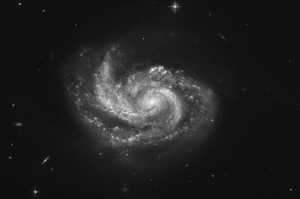NGC 2342
| Galaxy NGC 2342 |
|
|---|---|

|
|
| NGC 2342 Hubble Space Telescope | |
| AladinLite | |
| Constellation | Twins |
|
Position equinox : J2000.0 , epoch : J2000.0 |
|
| Right ascension | 07 h 09 m 18.08 s |
| declination | + 20 ° 38 ′ 09.5 ″ |
| Appearance | |
| Morphological type | S pec / HII / LIRG |
| Brightness (visual) | 12.5 mag |
| Brightness (B-band) | 13.2 mag |
| Angular expansion | 1.4 ′ × 1.3 ′ |
| Position angle | 126 ° |
| Surface brightness | 13.0 mag / arcmin² |
| Physical data | |
| Redshift | 0.017599 ± 0.000023 |
| Radial velocity | 5276 ± 7 km / s |
|
Stroke distance v rad / H 0 |
(233 ± 16) x 10 6 ly (71.3 ± 5.0) Mpc |
| history | |
| discovery | Albert Marth |
| Discovery date | November 10, 1864 |
| Catalog names | |
| NGC 2342 • UGC 3709 • PGC 20265 • CGCG 086-007 • MCG + 03-19-004 • IRAS 07063 + 2043 • 2MASX J07091808 + 2038092 • NVSS J070918 + 203812 • KPG 125B • HOLM 086A | |
NGC 2342 is an active spiral galaxy from the Hubble type Sc with extended star formation in the constellation of twins on the ecliptic . It is an estimated 233 million light years from the Milky Way and about 95,000 light years in diameter. Together with NGC 2341 , it forms the gravitationally bound galaxy pair KPG 125 or Holm 86 .
The object was discovered on November 10, 1864 by the astronomer Albert Marth using a 48 inch reflector telescope and is therefore listed in the New General Catalog .
